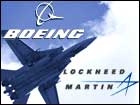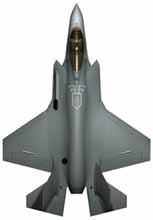|
Lockheed awarded contract
|
 |
October 26, 2001: 6:09 p.m. ET
Defense Dept. taps Lockheed-Martin for $200B Joint Strike Fighter.
|
NEW YORK (CNNmoney) - The U.S. Department of Defense Friday awarded Lockheed-Martin Corp. a contract that could be worth upwards of $200 billion to build its new radar-evading Joint Strike Fighter.
Lockheed, the nation's No. 1 defense contractor, beat out rival Boeing Corp. for the coveted deal, the largest in U.S. military history.
"The Lockheed Martin team is the winner on a best-value basis," said Jim Roche, Secretary of the Air Force who announced the contract award along with Undersecretary of Defense Edward "Pete" Aldridge.
| |

|
|
The government choose Lockheed-Martin's Joint Strike Fighter design (Source: Lockheed-Martin) | |
Officials made the announcement at a press conference Friday at the Pentagon.
Lockheed's shares jumped in after-hours trading Friday to $52.70 after finishing the regular session up $1.02 at $49.92. Boeing's shares slipped to $35.05 in after-hours trading. It finished the regular session up $1.78 at $37.68.
Though a valuable contract, the fighter is not expected to immediately impact Lockheed's bottom line, analysts said.
"We look at it on a cash-flow basis. We regard it as pretty fairly valued. But even with this new contract there's no real near-term impact," Deutsche Banc Alex Brown aerospace analyst Chris Mecray told CNNmoney's Markets Impact Friday.
Aldridge said conditions of the contract do not require Lockheed-Martin (LMT: Research, Estimates) to share any of the work with Boeing (BA: Research, Estimates), but added that the government would not stop them from doing so.
"While the Boeing team was not selected, they did an excellent job in the process," Aldridge said. "If Lockheed-Martin wishes to use the unique talents of Boeing they may do so."
In a statement following the announcement, Boeing CEO Phil Condit praised his employees' hard work and congratulated Lockheed.
"Although the government's Joint Strike Fighter announcement is disappointing to all of Boeing, I want to acknowledge the incredible effort by the men and women of the Boeing JSF One Team," Condit said. "This was an incredibly tough competition, and we congratulate Lockheed Martin. We're looking forward to the possibility of bringing our capabilities and skills to the Lockheed Martin JSF team."
Condit also said losing the contract forced Boeing to lower its revenue guidance for 2002 to $55 billion from $56 billion, but added that margins and cash flow would not be affected.
Roche said the aircraft, to be dubbed the F-35, would cost between $40 million and $50 million apiece. The jets are capable of a standard take-off and landing, short takeoff and vertical landing, and an aircraft carrier landing.
The Joint Strike Fighter is intended to replace the nation's aging fleet of fighter aircraft including the A-10 and the FA-16. The plane is expected to be the government's primary fighter aircraft beginning in 2008 through 2040, Aldridge said. The United Kingdom plans to replace its Sea Harrier and GR7.
The initial phase of the contract, which includes development and production of 14 aircraft for the U.S. Air Force, Navy, Marines and the United Kingdom's Royal Air Force and Navy, is valued at about $20 billion.
Additionally, Pratt & Whitney Military Engines, a unit of United Technologies (UTX: Research, Estimates), was awarded a more than $4 billion contract to develop the fighter's F135 engine. The contract includes ground and flight testing as well as production.
The contract also calls for Pratt & Whitney to compete with General Electric (GE: Research, Estimates) and Rolls Royce for the development of two propulsion systems.
Boeing, the Pentagon's No. 2 contractor, "could more easily absorb the loss," partly because it has an unmanned combat aircraft in the pipeline, likely to be a huge new business, McCutchan said.
Though Boeing may be more readily able to absorb the costs, Lockheed is also in a strong financial position. On Friday the company posted a higher third-quarter profit that beat Wall Street expectations and raised its outlook for fiscal 2001 and 2002.
The contract undoubtedly means a big boost to Lockheed's bottom line over time, but analysts say it's important to remember that it is just one contract, and that other ventures such as the unmanned drone surveillance planes, have an easier, strong potential for profits.
"What one sometimes fails to remember is that this contract is over a 30-year time frame fully funded," said Peter Jacobs, an aerospace analyst at Wells Fargo Van Kasper. "And that doesn't take into account budgetary pressures and delays. Everybody thinks this $200 billion kicks in tomorrow, but remember, the JSF does not go into service until 2010."
Jacobs also pointed out that 25-30 percent of the contract's value goes to the engine manufacturers and one-third of the contract goes to the companies that produce the avionics and radar systems.
| |

|
|
Boeing's version of the Joint Strike Fighter (Source: Boeing Co.) | |
The Joint Strike Fighter (JSF) is to be a family of high-performance, low-cost "stealth" aircraft, designed to evade radar and to replace Lockheed's F-16, the world's best-selling fighter, and a host of other aging warplanes.
The United States and Britain, which has committed $2 billion of its own to development, plan to buy a combined total of 3,002 planes - purchases valued at more than $200 billion by the U.S. Congressional Budget Office.
In addition, as many as 3,000 more might be sold to other allies, adding another $200 billion or so to the contract's worth during the next 30 years.
But Merrill Lynch analyst Bryon Callan, in a report this week, said, "We would not be surprised to see a figure that is ultimately one-half or less of this total."
Initial production was due to begin in about 2005, but that could be accelerated as the U.S. moves to combat the Sept. 11 attacks with air raids on Afghanistan and possibly elsewhere.
Click here for a look at aerospace stocks
Even before the United States and Britain began retaliatory air strikes against targets in Afghanistan Oct. 7, a panel appointed by Defense Secretary Donald Rumsfeld had urged that the Navy version of the JSF be rushed to put a radar-evading, "stealth" warplane on carriers sooner than previously scheduled. No orders to speed things up have been received, said Kathy Crawford, a program spokeswoman.
Under current plans, the first aircraft are to be delivered in 2009 for service with the Marines in 2010, with the Air Force in 2011, and with the Navy and in Britain in 2012.
The program's objectives "seem to be satisfied by both of the designs," said Jacques Gansler, the Pentagon's chief weapons buyer during much of the competition and now a professor of public policy at the University of Maryland. Gansler declined comment on which way he expected the contract to go. 
-- from staff and wire reports
|
|
|
|
|
 |

|

